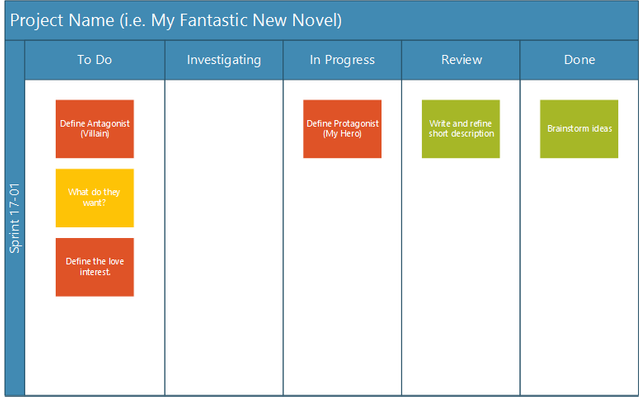Writers Should be Agile Too
What is Agile?
If you are not involved in software development, you might not be aware of the concept of agile development. The idea is that you track your project by tasks. Then each day, the team gathers around someone’s desk and each person tells the group what he or she did yesterday, what is planned for today, and any blockers that might keep the task from being completed.
It doesn’t sound like a big deal, but the whole agile process means breaking your project down into two-week increments called sprints. For each sprint in a project release, you examine the uncompleted tasks, a list called a “backlog” and select only the tasks that can be accomplished during the sprint. Part of the concept is that you don’t over-book yourself. Once the sprint starts, you work only on the tasks you have assigned to the sprint. Although extra tasks pop up occasionally, you are not distracted by the long list of tasks that need to be accomplished.

The tasks for the sprint are tracked on a board like the one pictured above. You have several columns, each of which represent the state of a task. You might have:
- To Do
- Investigating
- In Progress
- Waiting for Acceptance
- Done (or Accepted)
Tasks start of in the “To Do” column on the left and end up in the “Done” column on the right. It may sound weird, but there is something really satisfying about moving tasks around the board. Sometimes the scrum board will be represented by software but you can just as easily use a whiteboard and post-it notes.
This is a vastly simplified description of the process, but it is detailed enough for the purposes of this article. My point in writing this is that writers can benefit from adopting the agile methodology for their writing projects.
The benefits of agile software development for the individual developer include:
You always know what you have to do.
You don’t become overwhelmed trying to do everything at once
You can determine what everybody is working on and how their tasks relate to yours
The details of defining the tasks and selecting the work for a sprint means that you are actively engaged in the process
What does that have to do with writing?
.Most writers work alone. So why should they use a process that was created for development teams? The process adds focus. You pick the tasks you are going to work on and don’t have to think about the big picture all of the time, only once every two weeks.
Let’s consider the process of writing a novel. You know what you have to do, but supposing you decided to apply agile concepts to writing that novel?
Start by laying out a list of the tasks that you have to perform to get the novel ready for submission:
- Come up with the idea.
Maybe set up several tasks for brainstorming, testing the idea, refining the short description. . . - Define the characters.
You might break this down further and say, define the protagonist, antagonist, etc. - Write an outline.
This is another task that could be broken down into a series of sub-tasks. - Organize the outline into chapters
Books have chapters, chapters have scenes, lots of opportunities to create tasks and sub-tasks here. - Write the first draft
This would certainly cry out for making a list of scenes and/or chapters and creating a task for each. - Review/edit the book
Here you would create a task for each major section, and perhaps tasks for updating the order of events. - Write the synopsis
Do you want to do this all at once or write a synopsis of each chapter? Either way this makes up at least one task and maybe more. - If you don’t have an agent, you might sprinkle tasks for finding one throughout your other tasks
- Create your proposal project
- More? You could get very specific or keep it general.
You can adjust the amount of detail to match the project you are working on. You can create a one-day or one-week sprint for writing a short story or create a project that has a backlog several 2-week sprints long.
The idea was suggested by the comment a friend of mine made about applying agile to writing flash fiction. He said that for a 1,000 word flash fiction story, he creates five ten-minute “sprints” and makes a list of what he wants to do with each of the 200-word sections of his story. As he writes each one, if he accomplishes the goal for that section in less than 200 words, he adds the left over to the next sprint.
That description of agile writing made me consider how you could apply that concept to longer documents. I this it just might work.
What do you think?

Who is Irene P. Smith? I am an author, programmer, and web designer. A former Contributing Editor to PC Techniques Magazine, I have written about computers and programming since 1989, and began publishing fiction in 2003. My home is in New York State, along the Delaware River, where I live with my husband and son.

You can also find me elsewhere on the web:
- My "other" blog: An Irene Thing
- My Author's Website: irenepsmith.com
- My Professional Website: irenesmith.com
- Flash Fiction eZine: Nimue’s Grotto
- Writing eZine: Dreams in Transit
- Facebook: IrenePSmithAuthor
- Twitter: @Story_Teller